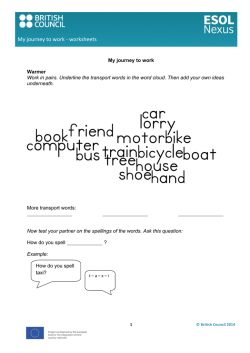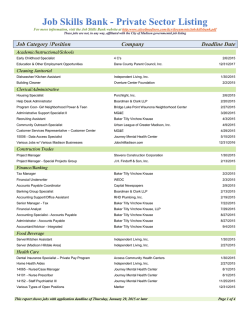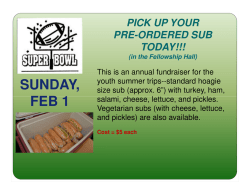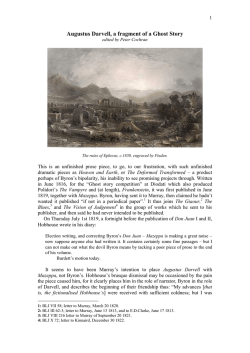
Creating a Customer-Focused Customer Experience Journey Map
Creating a Customer-Focused Customer Experience Journey Map 10+4 Principles to Capture Your Customer Experience Jim Tincher, Principal Consultant [email protected] Creating a Customer-Focused Customer Experience Journey Map A customer journey map charts your customer’s experience and helps you target improvements with the greatest return. By identifying those steps in the customer experience with the greatest impact, your journey map becomes a centerpiece to your customer experience planning process. This White Paper will explain what a customer experience journey map is, introduce the Guiding Principles of great journey maps, and will show examples of their implementation. Journey Maps: The Foundation for Planning Your Customer Experience Customer experience journey maps go by different names, such as customer experience maps, journey maps, and touch point maps. A map is a visual means to identify the steps a customer goes through as they experience your product or service. See pages 5 and 6 for examples. Journey maps are used for different reasons, with the two most common being: 1. Understand Touch Points. Touch Point Maps show each customer interaction within a larger experience—whether a consumer or business customer. A primary goal is to understand which touch points are used, and how each assists or interferes with the process. Many experiences include touch points outside of a company’s direct control, such as friends and family, social media and third-party websites. Each has an impact on the journey and needs to be understood. 2. Understand Emotional Impact. Every journey has an emotional impact on your customer, even in a business-to-business relationship. Whereas Touch Point Maps identify which interactions exist in an experience, Emotional Impact Maps target a specific phase and how each interaction builds or destroys value in your customers’ eyes. As visual artifacts these are powerful tools to teach you how the journey impacts your customers. They are also effective ways to unlock the secrets to improve loyalty and avoid defection. Guiding Principles Heart of the Customer uses ten guiding principles to create Customer Experience Journey Maps: 1. Maps represent your Customer’s perspective. Your journey map needs to represent the interactions as your customer experiences it. For example, when studying the shopping education process for a retailer, we discovered that most of the shopper education was complete before they ever visited that retailer or their website. This directly impacted how the retailer went to market, as they realized they needed to influence these other sites’ content. 2. Measure your brand promise. A journey map begins with your brand promise, and identifies how it is supported by your customer experience. If your brand promise is to have an experience that is effortless, highly customized, or unique, then your journey map needs to show whether your customers feel you are meeting that goal. 3. Require qualitative research. Qualitative research focuses on the why. Depending on the scope, the mapping process can involve interviews or ethnographies. Surveys can complement these with a broader perspective, but are not sufficient by themselves. 4. Represent your Customer segments. Different segments experience your products and services very differently. In a project for a service company we found that one segment spent two hours researching the category while another spent over six weeks doing the same, using very different tools. Trying to combine these very different experiences creates a diluted map that applies to no one. 5. Include your Customer goals. A great journey map shows what your customer is trying to accomplish at each stage of the process. Goals change as the process unfolds. Creating a Customer-Focused Customer Experience Journey Map 2 6. Communicate your Customer emotions. Emotions are critical to any experience, whether B2B or B2C, and the best customer journey maps clearly communicate these emotions and how they change as the experience unfolds. Some maps use smiley and frowny faces to communicate the customer’s emotional state. At Heart of the Customer we prefer to use satisfaction scores and colors to show the relative state of your customer. 7. Document your touch points. Many customer journey maps are built to demonstrate the order and type of touch points. The best maps show the emotional impact of each touch point. 8. Highlight your Moments of Truth. We define a Moment of Truth as a touch point with high impact to the rest of the process. Some interactions matter more than others. Great maps identify those critical Moments of Truth. For example, a bad hospital check-in taints the rest of the patient experience. 9. Include your Customer time progression. The length of your customer experience can vary, which is critical to understand. Does your customer’s typical call last 30 seconds or 10 minutes? Did shoppers spend 20 minutes or 40 hours deciding on a product? Does this vary by segment? 10. Ditch the PowerPoint. Why limit yourself to PowerPoint for something as important as your customer experience? Your map should be an oversized creation that can become the focal point for conversations – not something projected in a dark room. Some optional principles to consider: 1. Break the experience into phases. In a longer experience, customers are accomplishing different things at different times. For example, early shopping phases typically involve trying to figure out what questions to ask, whereas later phases are more transactional. Shorter transactions may not require phases. 2. Bring in Customer Verbatims. While not strictly required, verbatims bring the customer experience to life. If not used in your journey map, then definitely include them in the surrounding education. 3. Include Non-Customers. In a pre-sales journey, non-customers may be following a different path to make a decision. One of our research projects showed how non-customers were far more likely to use in-person meetings to make a purchase decision – which our client did not offer. This gap directly impacted their customer experience strategy. 4. Incorporate your other Voice of the Customer components. Rather than being separate from other research, the journey map should reflect components of your Voice of the Customer program (NPS, Satisfaction, the Customer Effort Score) to link it to your other efforts. These 10+4 principles will ensure you have a rich document that can serve as the foundation for your customer experience efforts. Applying the Principles Heart of the Customer uses these principles to create two primary types of maps: the Touch Point Map and the Emotional Journey Map. Let’s look at each in turn. Creating a Customer-Focused Customer Experience Journey Map 3 Using the Touch Point Map The following touch point map (the XYZ Company Purchase Journey Map on page 5) shows the journey the Young Families segment uses to purchase a home theater. Notice that this version focuses on the Young Families segment – the process looks very different for the Digital Enthusiast or the Middle-Aged Music Lover. The most visible spot on the map is the photo representing your customer segment. That is deliberate, in that it focuses the reader on that customer to learn more about the segment first. The eye is then drawn to more information about the segment, including the verbatims below. Since the purpose of this map is to understand the research and analysis journey, those touch points form the center of this map. Depending on the experience, In-Depth Interviews, Ethnographies, or Online Journaling can be used to collect the data behind your Customer Experience Journey Map. We also use the Customer Effort Score to understand the opportunities to lose customers as they go through the journey. This score compares the level of effort to the amount of effort the customer expected. The Customer Effort Score has a critical link to loyalty, in that experiences that require more effort than expected lead potential customers to drop out of a process before your sales channel has the opportunity to intervene. Using Your Touch Point Map to Drive Change This map facilitates organizational discussions about how each touch point contributes to your customer’s experience. How would your strategy change if you knew each of these about your customer’s purchase journey? Friends and family are far more likely to kick off a research process than is advertising. Seeing your product category at a friend’s house creates the curiosity necessary to begin the research process. How does this change your marketing and branding strategy? The two highest-impact moments occur outside of your control, when potential customers look at review sites and other third-party sites. How are you engaging third-party sites to make certain the products you carry are included and reviewed fairly? The one Hot Zone is your web site’s research functionality. A Hot Zone is an area with high importance and low satisfaction. Fortunately, purchasing at your retail store is a Bright Spot, with high customer scores. How will this knowledge impact how you deploy your resources? The Research Phase has a high Customer Effort Score, meaning it takes far more work than your customers expect. Can you gain market share if you can simplify this process for them? Creating a Customer-Focused Customer Experience Journey Map 4 Creating aCustomer Customer Customer-Focused Journey Map Sample Experience TouchExperience Point Map 5 Sample Customer Experience Impact Map Customer Experience Journey Map Journey Emotional Map 2—Emotional Using the Emotional Impact Map Contrast the Touch Point Map to the Emotional Impact Map on page 6. This map involves scheduling a physical exam for members of the Seniors Segment. The center focuses on the customer’s emotional levels. Touch points are still included and moments of truth are called out – but the focus is on your customer’s emotions as they travel through the experience. Understanding this emotional impact typically requires ethnographies or journaling, combined with quantitative surveys to collect the scores. Using Your Emotional Impact Map to Drive Change This map facilitates organizational discussions about how customers experience the journey, and how each touch points improves or degrades the customer’s emotional response. How would your strategy change if you knew: Two weeks is the magic time for appointment availability – patients who have to wait longer than two weeks are far less satisfied with the process, and are more likely to leave your practice altogether. The mailed reminder engages seniors, and is very well-received, whereas other segments have a neutral or negative response. What will you do when budget pressures threaten to cut this offering? The speed of check-in is a moment of truth that impacts the rest of the experience. Loud rooms or waits beyond ten minutes cause a negative reaction that lasts for the rest of the physical. The Check-In Process requires far more effort than Seniors expect from this process, receiving a Customer Effort Score of 4.6. Other segments have lower scores, suggesting that Check-In is a particular pain point for the Seniors Segment. Understanding the B2B Customer Experience Journey While both of these examples represent B2C customer experiences, we apply the same tools to business customers. In fact, mapping the B2B customer experience is often more critical, since the loss of a single customer has significant impact on your business. We regularly analyze the customer experience through Opportunity Studies, which focus on understanding the purchase process and why customers select you or a competitor. There are three primary reasons to map your B2B customer experience: 1. The cost of a new customer acquisition is increasing dramatically. This makes it even more important to understand your existing purchasing experience, to improve your win rate. It also makes it critical to measure your existing loyalty, as the cost of replacing each customer is increasing. 2. The research has an immediate ROI. Similar to B2C Customer Experience Journey Maps, the research results often lead to both long-term and short-term responses. Most of our customers find they can implement immediate action that more than pays for the research costs. 3. It is an opportunity to show the prospect you care. Our customer’s customers regularly provide feedback on how much they appreciate that the company is asking about their business, which improves loyalty. In addition to uncovering the reasons you win or lose, we also identify the process that is used to make a decision, helping you to better uncover opportunities. Creating a Customer-Focused Customer Experience Journey Map 7 About the Author Jim Tincher, Heart of the Customer Principal Consultant Jim Tincher is the principle Customer Experience consultant at Heart of the Customer. Jim has more than 20 years of experience in driving customer engagement and intimacy from small business to Fortune 500 companies. Jim’s Voice of the Customer expertise has led to engagements as far-reaching as developing consumer tests at Best Buy, creating a Customer Insights capability at UnitedHealth Group, and consulting with clients ranging from global fast food companies to utilities to international manufacturing and service companies. Jim is a dynamic keynote speaker, passionate about building a world-class customer experience that results in customers who come back time and again. To learn more about creating your own customer experience journey map, contact Jim at [email protected] or 612-747-4021.
© Copyright 2026





